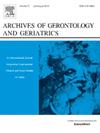老年髋部骨折合并心房颤动患者住院预后的预测因素:一项全国住院患者样本分析
IF 3.8
3区 医学
Q2 GERIATRICS & GERONTOLOGY
引用次数: 0
摘要
目的:患有房颤(AF)的老年人髋部骨折需要手术治疗,其发病和死亡风险增加。本研究旨在确定这些患者的住院死亡率和延长住院时间(LOS)的预测因素。方法回顾性分析美国(US)全国住院患者样本(NIS)数据库中2016年至2020年间接受髋部骨折手术治疗的≥60岁房颤患者。评估的结果是住院死亡率和延长的LOS(≥7天)。进行多变量逻辑回归来确定这些结果的危险因素。结果在43,667例符合条件的患者中,院内死亡率的最强预测因子是败血症(校正优势比[aOR] = 6.45)、呼吸衰竭(aOR = 5.91)、肝脏疾病(aOR = 2.61)和急性肾损伤(aOR = 2.40)。其他预测因素包括肺炎、高龄、高损伤严重程度评分(ISS≥16)、深静脉血栓形成、肺栓塞和心力衰竭伴射血分数降低(HFrEF)。对于延长的LOS,最强的独立预测因素包括败血症(aOR = 4.84)、肺炎(aOR = 3.25)、深静脉血栓形成(aOR = 4.62)、呼吸衰竭和高龄。结论:这些结果表明,严重并发症和合并症对老年髋部骨折合并房颤患者住院死亡率和LOS的影响。这些发现特别支持需要警惕和加强围手术期管理,针对败血症、呼吸系统并发症和肾功能,以改善这一高危人群的预后。本文章由计算机程序翻译,如有差异,请以英文原文为准。
Predictors for in-hospital outcomes in older patients with hip fracture and atrial fibrillation: A Nationwide Inpatient Sample analysis
Purpose
Older adults with pre-existing atrial fibrillation (AF) who sustain a hip fracture that requires surgery are at increased risk of morbidity and mortality. This study aims to identify predictors of in-hospital mortality and prolonged length of stay (LOS) in these patients.
Methods
The United States (US) Nationwide Inpatient Sample (NIS) database was retrospectively reviewed for patients ≥ 60 years old with AF who underwent surgical management of a hip fracture between 2016 and 2020. Outcomes evaluated were in-hospital mortality and prolonged LOS (≥ 7 days). Multivariable logistic regressions were performed to identify risk factors for these outcomes.
Results
Among 43,667 eligible patients, the strongest predictors for in-hospital mortality were sepsis (adjusted odds ratio [aOR] = 6.45), respiratory failure (aOR = 5.91), liver disorders (aOR = 2.61), and acute kidney injury (aOR = 2.40). Other predictors were pneumonia, advanced age, high Injury Severity Score (ISS ≥ 16), deep vein thrombosis, pulmonary embolism, and heart failure with reduced ejection fraction (HFrEF). For prolonged LOS, the strongest independent predictors included sepsis (aOR = 4.84), pneumonia (aOR = 3.25), deep vein thrombosis (aOR = 4.62), respiratory failure, and advanced age.
Conclusion
These results indicate the impact of critical complications and comorbidities on in-hospital mortality and LOS in elderly hip fracture patients with pre-existing AF. These findings particularly support the need for vigilance and enhanced perioperative management targeting sepsis, respiratory complications, and kidney function to improve outcomes in this high-risk group.
求助全文
通过发布文献求助,成功后即可免费获取论文全文。
去求助
来源期刊
CiteScore
7.30
自引率
5.00%
发文量
198
审稿时长
16 days
期刊介绍:
Archives of Gerontology and Geriatrics provides a medium for the publication of papers from the fields of experimental gerontology and clinical and social geriatrics. The principal aim of the journal is to facilitate the exchange of information between specialists in these three fields of gerontological research. Experimental papers dealing with the basic mechanisms of aging at molecular, cellular, tissue or organ levels will be published.
Clinical papers will be accepted if they provide sufficiently new information or are of fundamental importance for the knowledge of human aging. Purely descriptive clinical papers will be accepted only if the results permit further interpretation. Papers dealing with anti-aging pharmacological preparations in humans are welcome. Papers on the social aspects of geriatrics will be accepted if they are of general interest regarding the epidemiology of aging and the efficiency and working methods of the social organizations for the health care of the elderly.

 求助内容:
求助内容: 应助结果提醒方式:
应助结果提醒方式:


